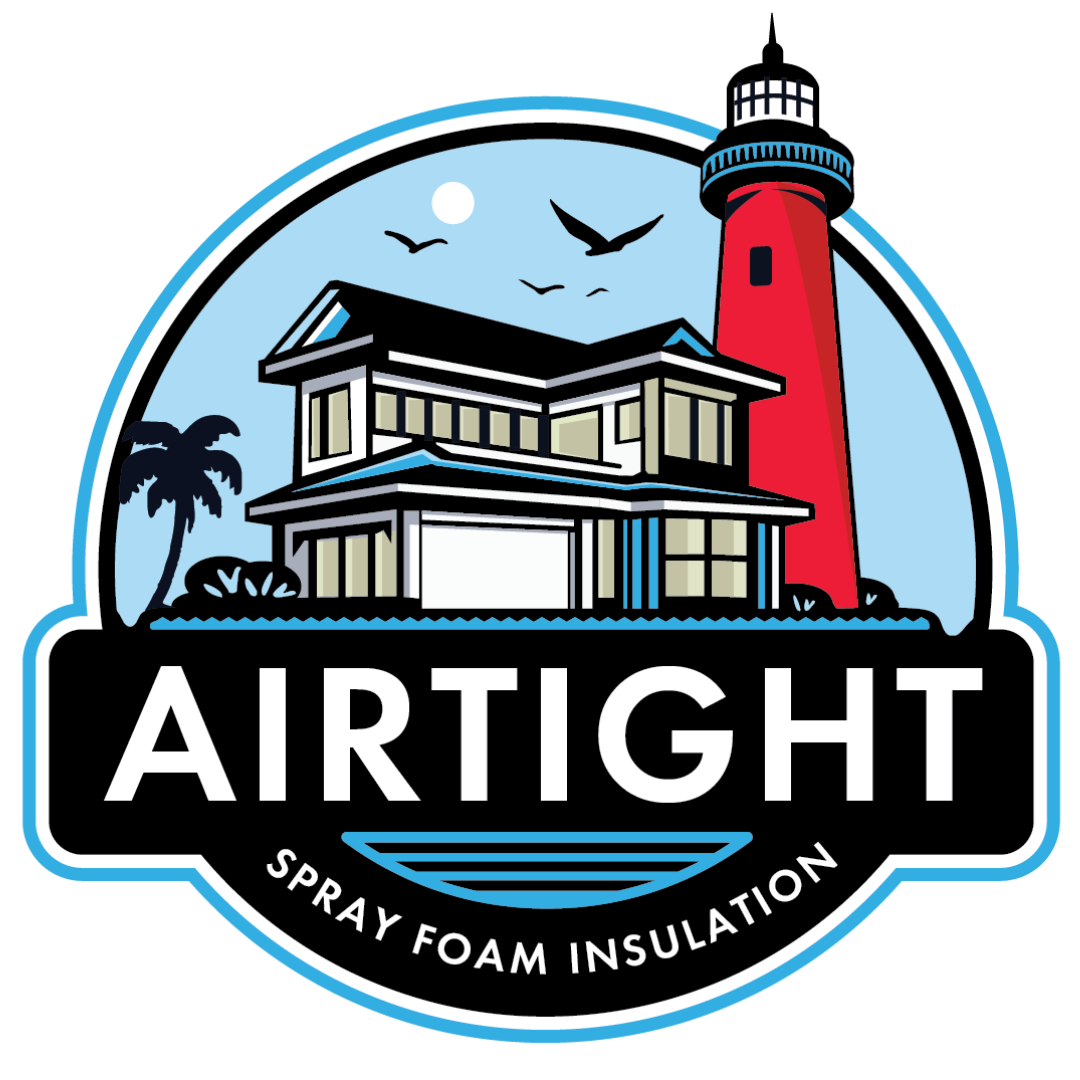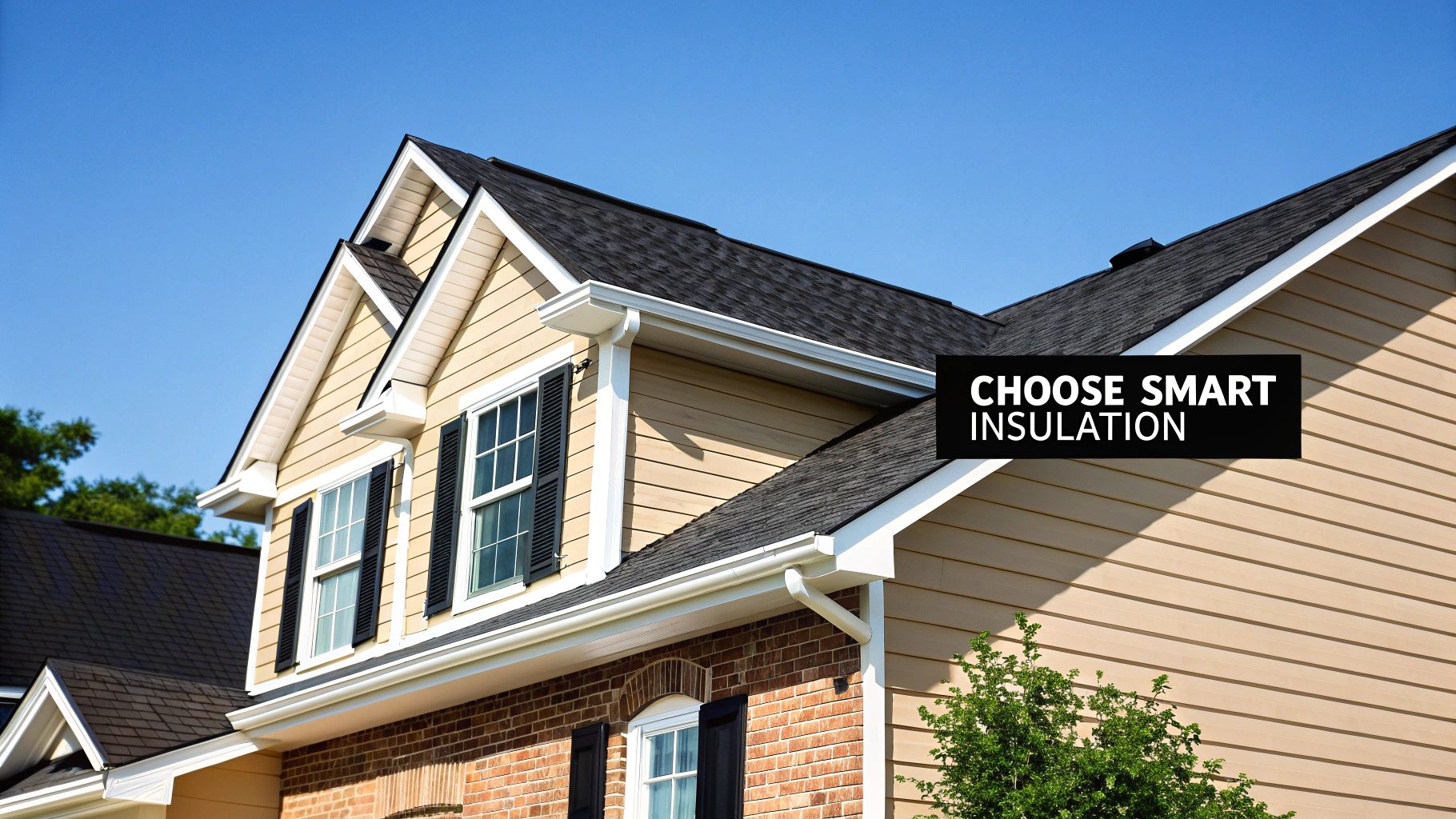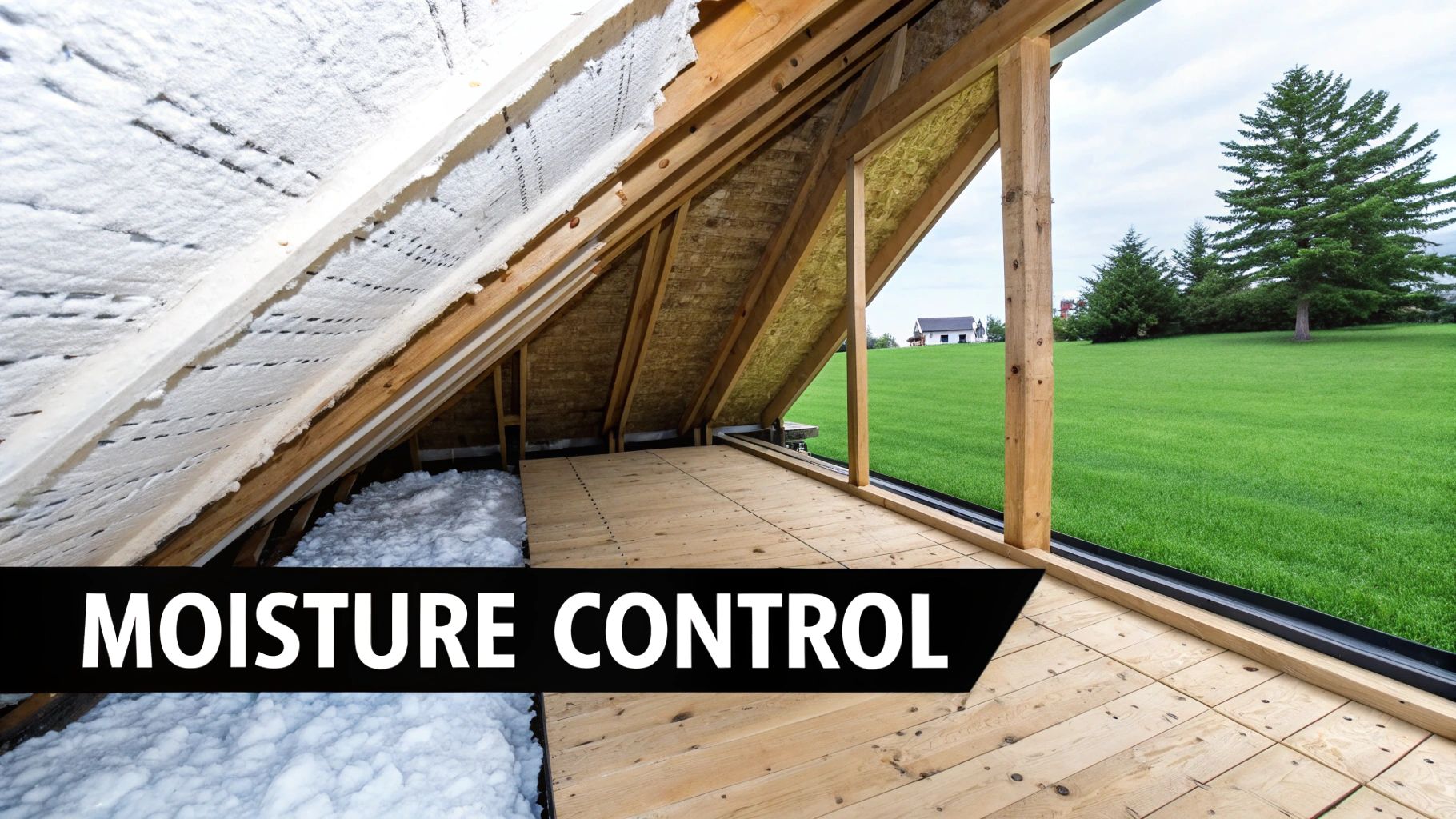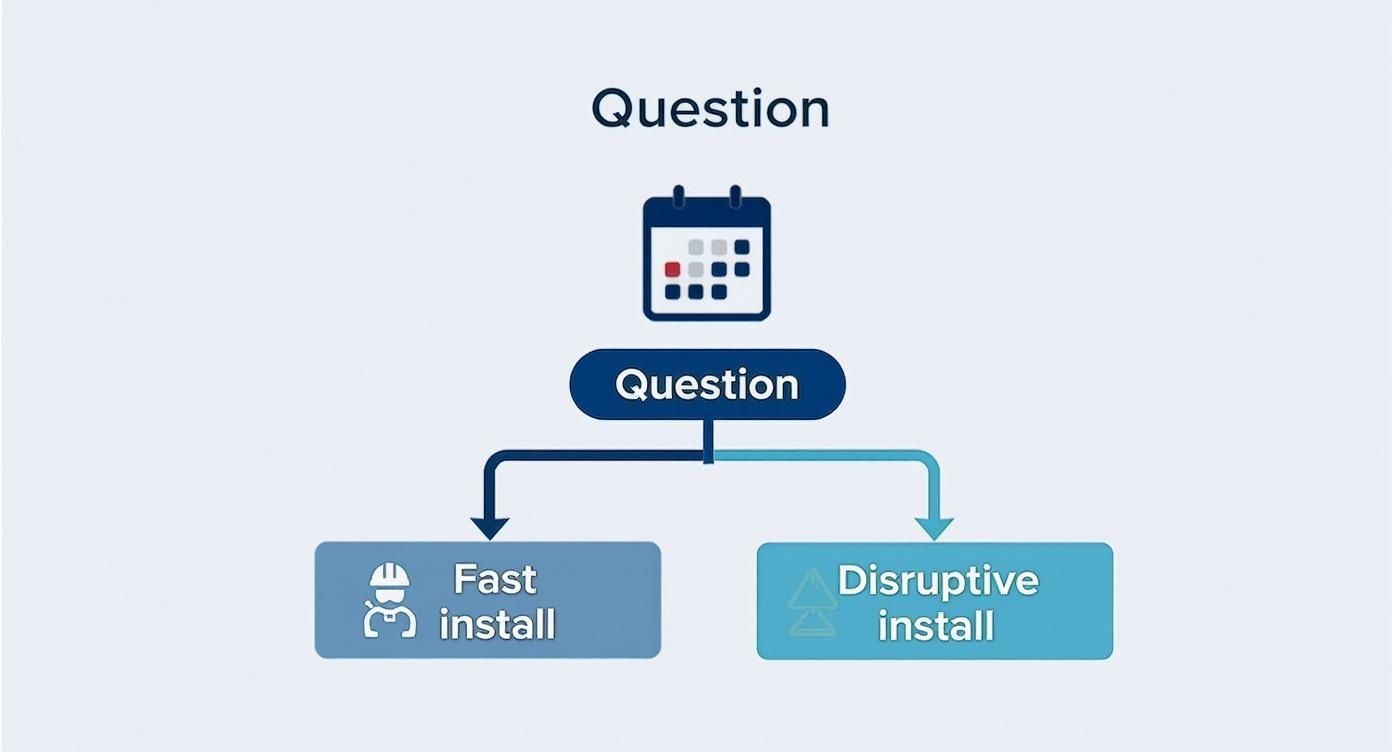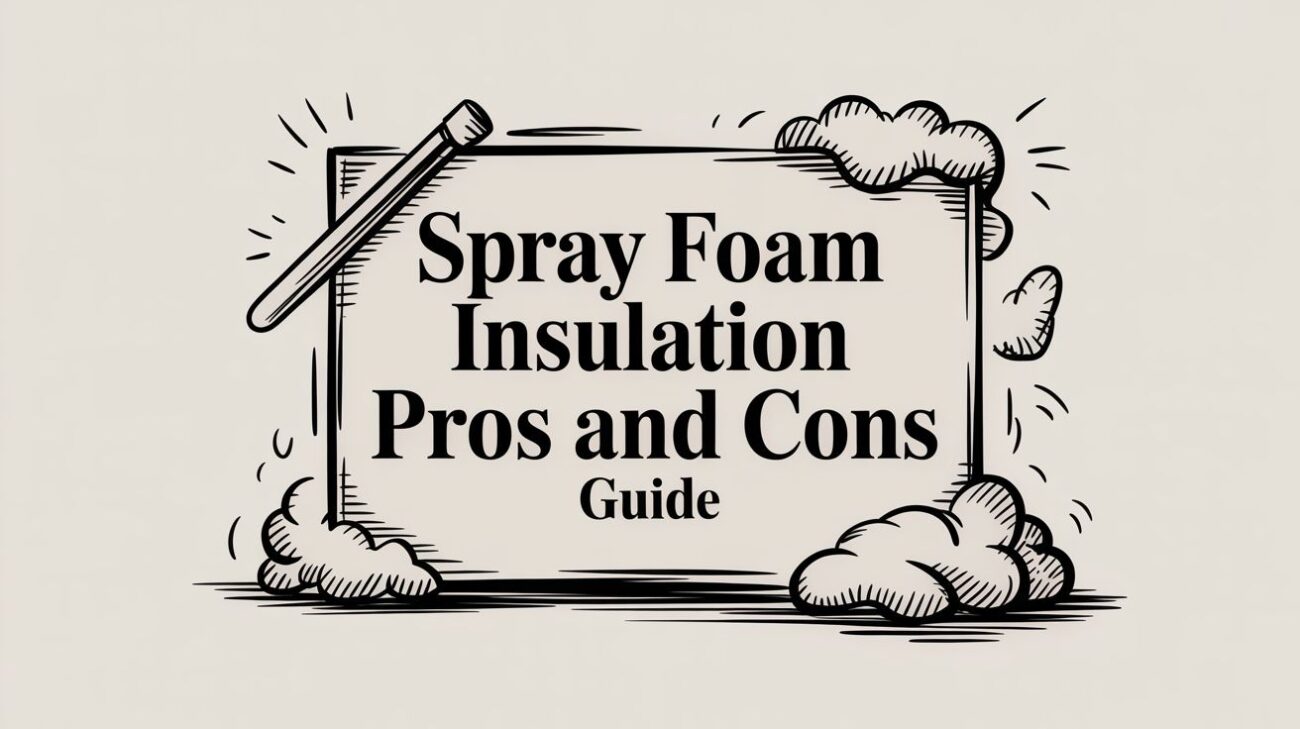Spray Foam vs Blown In A South Florida Home Guide
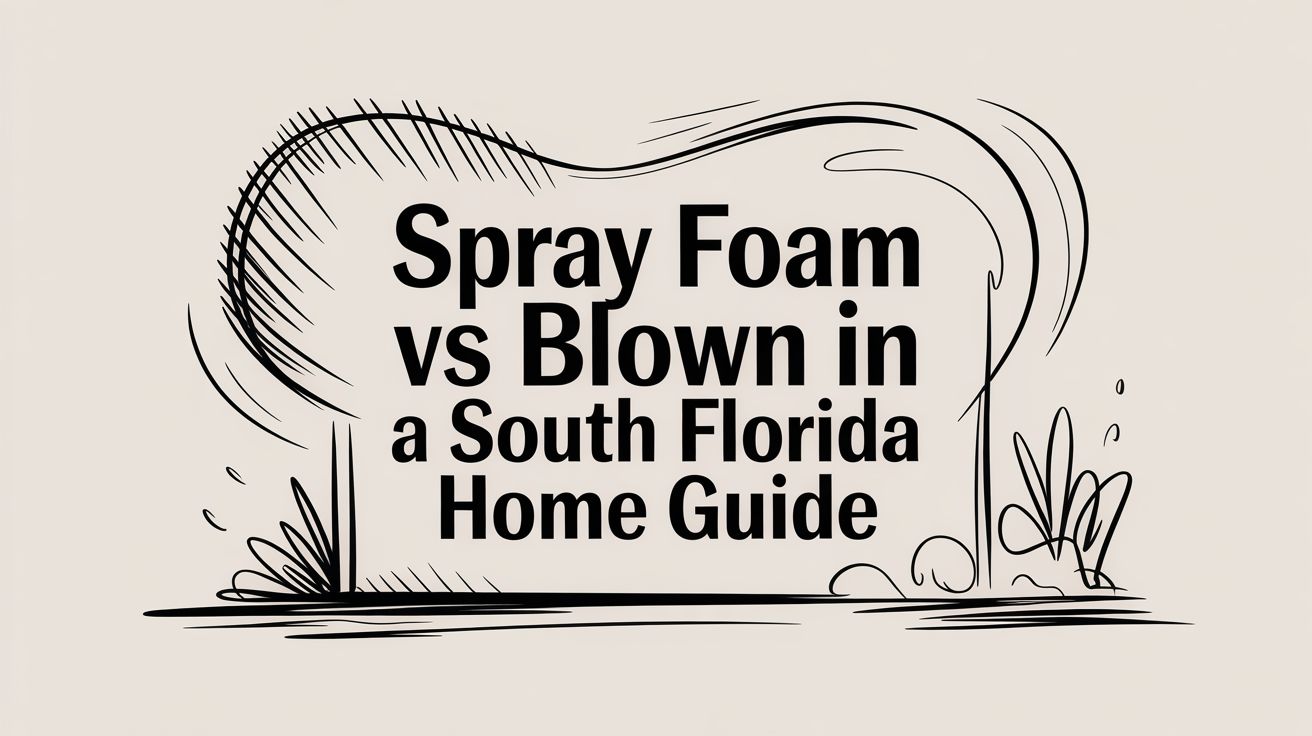
When you're weighing spray foam vs. blown-in insulation, the right choice really comes down to what you're trying to accomplish. For homeowners here in South Florida, if your main goal is to get the absolute best performance against our brutal humidity, seal up every air leak, and maximize your long-term energy savings, closed-cell spray foam is in a class of its own.
But if you're focused on a solid thermal upgrade without the higher upfront investment, blown-in insulation is still a very practical and effective choice.
Choosing the Right Insulation for South Florida Homes
This guide goes beyond the basics to dig into the performance differences that truly matter in our climate. We'll look at how each insulation type handles intense heat, non-stop humidity, and even storms, so you can make a clear-headed decision for your property. The choice you make impacts everything from your FPL bill to how well your home holds up year after year.
Deciding between spray foam and blown-in isn't just about R-value; it's about creating a complete building envelope that works for you. The key factors really boil down to these three things:
-
Your Budget: Are you focused on the lowest initial cost, or are you playing the long game with return on investment?
-
Performance Goals: Do you just want to be more comfortable, or are you aiming for peak energy efficiency and a fortress against moisture?
-
Climate Demands: South Florida’s heat and humidity require insulation that does more than just slow down heat transfer.
The best insulation for our region is one that actively controls both air and moisture, not just temperature. This is where the difference between creating a true airtight seal and simply filling a space with fluffy material becomes crystal clear.
This comparison is designed to give you real-world knowledge, helping you look past the price tag to understand the true value each insulation brings to your home. Using the right materials is about more than just comfort—it’s about creating a healthier home that’s built to last. For more ideas on eco-friendly home improvements, check out some green interior design inspiration on our blog.
Insulation Decision-Making Quick Guide
Making the right call can feel complicated, so we put together this quick guide. It helps you match your top priority with the best insulation solution for your South Florida home.
| Choose This Insulation… | …If Your Top Priority Is |
|---|---|
| Closed-Cell Spray Foam | Maximum energy savings, total moisture prevention, and adding structural strength. |
| Open-Cell Spray Foam | Excellent air sealing and sound dampening at a more moderate price point. |
| Blown-In Insulation | A budget-friendly thermal upgrade, especially for an existing attic or wall. |
Think of this as your starting point. Closed-cell is the premium, all-in-one solution, while open-cell offers a great balance of air sealing and cost. Blown-in gets the job done when the budget is the primary driver.
Getting to Know Your Insulation Options
Before we jump into a head-to-head comparison of spray foam vs. blown-in insulation, it’s important to understand what these materials actually are. They aren’t just different brands of the same thing—they're fundamentally different products designed to solve different problems. Each has a unique makeup, is installed differently, and brings its own strengths to the table.
Spray foam insulation starts as two separate liquids. When mixed, they react chemically and expand, sometimes up to 100 times their original volume. This rapid expansion is what allows the foam to fill every tiny crack and gap, creating a seamless, airtight seal that stops heat transfer in its tracks.
Blown-in insulation, on the other hand, is a loose-fill material. It’s made up of small clumps of fiberglass or cellulose that are literally blown into an attic or wall cavity with a powerful hose. Its effectiveness comes from trapping air between all those tiny fibers, which slows down the movement of heat.
The Two Faces of Spray Foam
Spray polyurethane foam (SPF) isn’t a one-size-fits-all product. It comes in two primary types, and the differences between them are significant.
-
Closed-Cell Spray Foam: Think of this as a dense, rigid foam. As it cures, its cells lock up tight, trapping a special gas that boosts its insulating power. This rigid structure makes it incredibly strong, waterproof, and a true powerhouse insulator.
-
Open-Cell Spray Foam: This version is much lighter, softer, and more flexible—almost like a dense sponge. Its cells are left open on purpose, which makes it fantastic for sealing air leaks and dampening sound. It’s not a moisture barrier, though, and has a lower R-value per inch than closed-cell.
The real game-changer is the cell structure. Closed-cell foam forms a rock-solid barrier against both air and moisture. Open-cell foam stops air dead in its tracks but wisely allows water vapor to pass through it, letting the structure breathe.
The Composition of Blown-In Insulation
Blown-in insulation also offers two popular material choices, each with a different background and distinct properties.
-
Fiberglass: This is the fluffy pink or white stuff you’re probably familiar with. It's made from molten glass spun into fine fibers, making it naturally resistant to fire and moisture. It’s a go-to choice for topping up existing attic insulation.
-
Cellulose: As the eco-friendly option, cellulose is made from up to 85% recycled paper products, like old newspapers. It’s treated with non-toxic borates, which act as a fire retardant and also make it resistant to pests and mold. Cellulose is great at packing tightly into odd-shaped spaces, minimizing air gaps.
With those basics covered, let’s see how these materials stack up on their core attributes. This quick look will set the stage for our deeper dive into how they really perform in South Florida’s demanding climate.
Core Attributes of Insulation Types
Here is an at-a-glance comparison of the fundamental characteristics of spray foam and blown-in insulation materials.
| Attribute | Closed-Cell Spray Foam | Open-Cell Spray Foam | Blown-In Insulation |
|---|---|---|---|
| Material Type | Rigid Polyurethane Foam | Spongy Polyurethane Foam | Loose-Fill Fibers |
| Primary Function | Air, Vapor & Thermal Barrier | Air & Sound Barrier | Thermal Barrier |
| Structure | Dense, Closed Bubbles | Soft, Interconnected Bubbles | Loose Particles (Glass/Paper) |
| Installation | Liquid-Applied, Expands | Liquid-Applied, Expands | Blown into Cavities |
This table gives you a snapshot of the key differences. But as any expert will tell you, the specs on paper are only half the story. Now, let’s get into the real-world performance.
Performance in a High-Humidity Climate
Here in South Florida, the real test between spray foam vs blown in insulation isn't what's on the spec sheet—it's how the material stands up to our brutal humidity and oppressive heat. This is where theory gets a reality check. Performance isn't just about a number; it's about whether your home stays cool, dry, and structurally sound through years of our punishing climate.
Let's cut through the noise and look at the three performance metrics that truly matter for homeowners here: R-value under real-world heat, air sealing, and the big one—moisture management.
R-Value Beyond the Label
An insulation’s R-value is its ability to resist heat flow. On paper, blown-in insulation looks decent with up to R-3.8 per inch, while closed-cell spray foam boasts a powerful R-7 per inch. But those numbers don't tell the full story in our environment.
The real test is how that R-value performs against both conductive heat (from the sun baking your roof) and convective heat (hot air moving around). Blown-in insulation slows down heat transfer, but it does absolutely nothing to stop air movement. On a sweltering August afternoon, that superheated attic air will still creep through gaps in the loose material, chipping away at its real-world effectiveness.
Spray foam, on the other hand, tackles both. Its high R-value fights the sun’s radiant heat, while its solid, seamless seal completely stops convective looping—the hot air currents that sneak heat into your house.
The Unmatched Power of Air Sealing
Air leakage is public enemy number one for energy efficiency in a hot, humid climate. It’s a two-way street of failure: your cool, conditioned air gets out, and hot, sticky air gets in. This is easily the biggest performance difference when you compare spray foam to blown-in materials.
Blown-in insulation is, by its very nature, a loose-fill product. It fills the big spaces between joists, sure, but it can’t seal the thousands of tiny gaps around wires, pipes, and framing. Over time, it can even settle, creating more pathways for air to travel.
Spray foam insulation doesn’t just sit in a cavity; it becomes one with the structure. By expanding into every last crack and seam, it creates a single, unbroken, and airtight barrier, effectively turning your attic and walls into a sealed, protected envelope.
This is precisely why spray foam can slash energy costs so dramatically. Your air conditioner is no longer fighting a losing battle against a constant invasion of hot air, so it runs less often and works more efficiently. Homeowners are catching on, and the market shows it. The global spray foam insulation market is expected to hit roughly USD 4.45 billion by 2035, a massive jump driven by the demand for true energy efficiency.
Dominating Moisture Management
For any home in South Florida, moisture is a constant enemy. It fuels mold, rots wood, and ruins indoor air quality. When it comes to handling moisture, the difference between closed-cell spray foam and blown-in insulation is night and day.
Blown-in cellulose and fiberglass are permeable. When humid air gets into your attic, these materials can soak up and hold that moisture like a sponge. This not only tanks their insulating R-value but also creates a perfect breeding ground for mold and mildew, especially in a stuffy, unventilated attic.
Closed-cell spray foam is a completely different animal. Its dense, rigid structure is non-permeable, meaning it acts as a true vapor barrier.
This delivers two massive advantages for your home:
-
It blocks humidity. That thick, moisture-heavy outdoor air simply can't pass through the insulation and into your attic or home.
-
It prevents condensation. By stopping hot, humid air from hitting the cooler, air-conditioned surfaces of your home (like the backside of your drywall), it eliminates the risk of condensation forming inside your walls or on the roof deck.
For homes in coastal communities like Jupiter, this kind of moisture defense isn't a bonus feature—it's an absolute necessity for the health and longevity of the building. To see how we apply this in local homes, check out our work with spray foam insulation in Jupiter, FL, where controlling moisture is our top priority. Closed-cell spray foam doesn't just resist water; it actively rejects it, protecting your home’s structure and giving you a healthier place to live.
Comparing Upfront Costs and Long-Term ROI
The financial side of the spray foam vs blown in debate is often where homeowners hit the pause button, and for good reason. There’s a real difference in the initial investment, and understanding the numbers—both now and down the road—is the key to making a confident decision. Let's break down the costs and, more importantly, the long-term value each option actually delivers.
Blown-in insulation almost always has a lower upfront price tag. With materials like fiberglass or cellulose coming in between $0.40 to $2.50 per square foot, it’s a very accessible option for homeowners working with a tight, immediate budget. The installation is also faster and less complex, which helps keep those labor costs in check.
Spray foam insulation, especially closed-cell, sits at a higher price point, generally ranging from $0.75 to $4.50 per square foot. This jump in cost comes from a few places: the chemical compounds are more expensive, the application requires specialized rigs and equipment, and the installation demands certified professionals who know how to apply it safely and effectively. But looking at this number in isolation is a huge mistake; it's only half of the financial story.
Shifting from Cost to Investment
The real evaluation starts when you stop thinking of it as a simple expense and start seeing it as a long-term return on investment (ROI). That higher upfront cost for spray foam isn't just for insulation; it's for a complete air and moisture barrier that fundamentally changes how your home performs. This is where the long-term savings really kick in.
Blown-in insulation definitely improves thermal resistance, and it will lower your energy bills compared to a poorly insulated attic. Homeowners can expect to see energy savings of up to 25%. While that's a solid improvement, it doesn't account for the energy lost through all the tiny air leaks that blown-in materials just can't seal.
The most crucial financial metric isn't the initial price—it's the payback period. Spray foam's ability to create an airtight seal means your HVAC system runs less, works more efficiently, and lasts longer, creating a powerful compounding effect on your monthly savings.
Spray foam's airtight seal dramatically cuts that energy waste. A deep dive into energy savings shows that spray foam insulation can reduce heating and cooling costs by up to 50% when stacked against traditional blown-in methods. This superior performance is because it stops convective heat loss in its tracks—a major source of energy bills that loose-fill materials don't solve. Over time, these bigger monthly savings not only cover the initial price difference but continue to put money back in your pocket for the life of your home. You can read more about these market-driven energy efficiency gains and see why spray foam is becoming a global standard.
A Real-World Financial Scenario
Let's imagine two identical South Florida homes, both with a $400 average monthly summer electric bill.
-
Home A installs blown-in insulation and gets a 25% reduction in cooling costs. Their new bill is $300, saving them $100 a month.
-
Home B invests in closed-cell spray foam and gets a 45% reduction. Their new bill is $220, saving them $180 a month.
Even though Home B paid more upfront, it's earning back its investment nearly twice as fast. Over a decade, Home B will have saved an extra $9,600 on energy bills compared to Home A. And that's not even counting the potential savings from needing a smaller, less strained HVAC unit or the increased resale value that comes with a verifiably energy-efficient home.
Ultimately, the choice comes down to your financial strategy. Blown-in insulation offers a straightforward, budget-friendly thermal upgrade with a respectable return. Spray foam, on the other hand, acts more like a strategic home energy investment, delivering deeper, more significant financial rewards that just keep growing over time.
The Installation Process and What to Expect
Let's move past performance specs and cost sheets for a moment and talk about what it’s actually like to have these different types of insulation installed. The experience couldn't be more different. One is a quick, low-impact upgrade, while the other is a more involved, technical procedure that requires your house to be vacant.
Understanding how each process works is key to figuring out what fits your timeline, your home, and your tolerance for disruption.
The Blown-In Insulation Method
Blown-in insulation is all about speed and simplicity. It’s the go-to choice for homeowners who want to boost their attic insulation without turning their life upside down. For most attics, the entire job is done in just a few hours.
A large truck with a hopper pulls up, and a long, flexible hose is run into the attic. Technicians inside direct the flow of loose-fill fiberglass or cellulose, spreading it like a thick, fluffy blanket across the attic floor. Prep work is minimal—they just need a clear path to the attic and will cover the immediate area to catch any dust.
Because the materials are inert and don't involve any chemical reactions, you and your family can stay in the house while the work is done. There are no fumes or safety concerns to worry about.
The biggest selling point for blown-in installation is how fast and non-disruptive it is. You get a significant thermal upgrade in a single afternoon without your home feeling like a construction zone.
The Spray Foam Insulation Application
Spray foam installation is on another level entirely. This is a highly technical process that absolutely should never be a DIY project. It demands certified professionals who are experts in the complex chemistry and precise application needed to get it right. It’s this commitment to professional standards that companies like Airtight Spray Foam Insulation bring to every single job.
First comes the prep work, and it’s extensive. The crew seals off the entire work area with plastic sheeting, meticulously covering floors, windows, and anything else that can’t be moved to protect it from overspray.
Once the area is secure, the installers suit up in full personal protective equipment (PPE), including respirators. This is non-negotiable, as the two-part liquid polyurethane releases volatile organic compounds (VOCs) while it’s being sprayed. The foam is applied directly to the surfaces—like the underside of the roof deck—where it expands in seconds to create a solid, seamless, and completely airtight barrier.
Here’s what the timeline typically looks like:
-
Day 1 (Morning): Extensive prep, sealing off the work zone.
-
Day 1 (Afternoon): Application of the spray foam to the specified depth.
-
Day 2 (24-Hour Period): The foam cures and "off-gasses." During this critical 24-hour window, the home must be completely vacant. This is a mandatory safety measure to let all VOCs dissipate, ensuring the air is perfectly safe when you return.
This required vacancy is the single biggest difference in the homeowner experience. It definitely requires more planning, but it's a protocol we never bend for the safety of your family. The payoff is a high-performance insulation system that’s permanently bonded to your home's structure.
Which Insulation Is Right for Your Home?
Deciding between spray foam vs blown-in insulation really boils down to your budget and what you’re trying to achieve long-term. There’s no magic bullet here—just the right solution for your specific home and goals. Let's cut through the noise and figure out which one makes sense for you here in South Florida.
Think of blown-in insulation as the fastest, most straightforward upgrade you can make. It's the go-to choice when your main goal is adding serious R-value to your attic without a huge upfront cost or major disruption. You'll feel the difference pretty quickly.
Spray foam, on the other hand, is a different animal entirely. It’s a complete overhaul of your home’s building envelope. This is the path for homeowners who are serious about putting an end to air leaks, crushing humidity, and sky-high cooling bills for good. Yes, it costs more upfront, but the ROI in a climate like ours is undeniable.
Scenarios to Guide Your Choice
To make it even simpler, let's walk through a few common situations we see all the time in South Florida homes. Matching the product to the problem is the key to getting it right.
-
For the New Construction Home: This is a no-brainer. Closed-cell spray foam is the gold standard. When you apply it directly to the roof deck during the build, you create a conditioned attic from the get-go. This locks in energy efficiency and protects the home's structure for decades.
-
For the Hot, Humid Attic in an Existing Home: If your attic feels like a steam room and you're fighting moisture, closed-cell spray foam is the only real fix. It acts as a complete air and vapor barrier, stopping humid air in its tracks. This not only prevents mold but also takes a massive load off your AC.
-
For a Budget-Conscious Thermal Upgrade: If your primary concern is just getting more insulation in the attic to fight the heat, and budget is king, blown-in cellulose or fiberglass is a smart move. It provides a solid boost in performance for a much lower initial investment.
This decision tree helps visualize the trade-off between how quickly the job gets done versus how involved the process is.
The bottom line is this: blown-in insulation is a quick and effective upgrade. Spray foam is a more permanent, high-performance solution that transforms how your home functions, but it's a more involved process.
Common Insulation Questions
When you’re weighing spray foam vs. blown-in insulation, a handful of practical questions always come up. Getting straight answers is the only way to make a decision you'll feel good about for years to come. Here are some of the most common concerns we hear from South Florida homeowners.
We're going to bridge the gap between the technical specs on a product sheet and what actually happens in your home. Let's dig into the real-world details on safety, installation, and how long your investment will actually last.
Is Spray Foam Insulation Safe for My Family?
This is usually the first question people ask, and for good reason. The answer is a definitive yes, but with a critical condition: it must be installed by certified professionals who follow strict safety protocols. The safety of spray foam is all about the installation and curing process.
During application, two liquid components mix and create a chemical reaction. This process does release volatile organic compounds (VOCs), which is why our installers wear full protective gear. It's also why we require the home to be empty during the job and for a 24-hour period afterward.
Once spray foam fully cures, it becomes an inert, stable plastic. It's completely non-toxic. It doesn’t off-gas or release any harmful chemicals, making it perfectly safe for your family and pets.
That 24-hour curing window is non-negotiable. It ensures that when you walk back into your home, the air is clean and the material is completely safe. This is why professional installation isn't just a suggestion—it's essential for guaranteeing the product performs safely and correctly.
Can New Insulation Be Installed Over Old Material?
You technically can do this, but in almost every situation—especially here in South Florida—it’s a terrible idea. Just piling new material over old, compressed, and potentially contaminated insulation is asking for trouble. It traps moisture, decades of dust, and allergens right where you don't want them.
Trying to save a few bucks by skipping removal completely undermines the performance of your new insulation. For blown-in, the old stuff is usually compacted and doing next to nothing for your R-value anyway. For spray foam, you absolutely need a clean surface for the foam to adhere to and create that all-important airtight seal.
Here’s why starting fresh is the only right way to do it:
-
Performance: A clean, bare surface lets the new insulation do its job at 100% effectiveness, delivering the R-value and air seal you're paying for.
-
Health: You get rid of years of accumulated dust, allergens, and hidden mold spores lurking in the old material.
-
Inspection: It gives us a chance to inspect the attic deck for hidden leaks, pest damage, or rot before sealing it all up.
Think of it like painting a wall. You wouldn't just slap a new coat of paint over dirty, peeling paint and expect it to look good or last. The same logic applies here. A clean slate guarantees the best outcome.
How Long Does Spray Foam Last Compared to Blown In?
When you’re talking about long-term value, durability is a huge factor. Blown-in insulation, whether it's fiberglass or cellulose, generally has a lifespan of 15 to 30 years. Over time, it settles and compacts under its own weight, creating gaps that kill its R-value. It’s also like a sponge if a roof leak occurs, which leads to mold and further performance loss.
Spray foam, especially closed-cell, is a completely different animal. It’s a permanent solution. Because it bonds directly to the structure and hardens into a rigid solid, it can't settle, sag, or lose its shape. Ever.
Spray foam has an expected lifespan of 50+ years, often lasting for the entire life of the building. Its moisture-blocking properties mean it won't absorb water or support mold growth, even in our sticky, humid climate. This isn't just an upgrade; it's a one-and-done investment in your home's future.
Ready to make your South Florida home healthier, quieter, and more energy-efficient? The experts at Airtight Spray Foam Insulation are here to help you choose the right solution. For a no-obligation consultation and a free estimate, visit us online at https://airtightsprayfoaminsulation.com.
